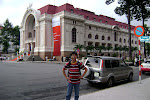 Where were you last June 4, 1989?
Where were you last June 4, 1989? Late 80s, I was probably teaching at UST CFAD and working at the House of Representative. June 1989? Honestly, I can’t remember.
The Internet was at its infancy. And we hadn’t heard of YouTube or Google or Yahoo.
Everybody got their news from newspapers and CNN. And around those days from April to June 1989, young Chinese students, intellectuals and workers were making their strong presence felt at Tiananmen Square. Yes, it has been 20 years since the Tiananmen Square protests that led to the death persecution of many Chinese.
The demonstrations were fueled by the sudden death due to heart attack of Hu Yaobang, who was seen by the protestors as pro-democracy and anti-corruption official. Around the middle of April, civilians had gathered at Monument to the People's Heroes in the middle of the Tiananmen Square to mourn his death.
Students from Peking University and Tsinghua University also expressed their sorrow and sympathy for Hu Yaobang by posting eulogies inside the campus. 500 students from China University of Political Science and Law marched to the Great Hall of the People.
Their numbers increased as 3,000 students from Peking University and hundreds more from Tsinghua University joined the growing protestors. Their presence increased to 100,000 towards the eve of his funeral on April 22, 1989.
Days turned into weeks. Protests evolved into petitions, known as the “seven demands” which the students wanted to give to government officials. While no officials came out to meet with the protestors, some officials were sympathetic to the protestors. The numbers grew as news about the dispersal spread and People's Daily issued a front-page editorial that accused "extremely small segments of opportunists of plotting civil unrest.” This was far from the real presence in Tiananmen Square. There were also marches in the streets of Beijing demanding that government renounce the “official statement.”

While there was pushing and shoving as the police tried to clear access to government offices, the protest was generally peaceful until the tanks rolled into Tiananmen Square which resulted to the death and injuries of civilians. This is a famous photo by Jeff Widener of AP.
No one outside China believes the exact figure has ever been given by the Chinese government. Only 241 dead and 7,000 wounded, including government soldiers. Unidentified sources from the Chinese Red Cross gave a figure of 2,600 deaths.
There was a widespread crackdown of other protestors and their supporters. Media was suppressed (even today), as it has always been gagged.
Students and workers demanded a dialogue with government. Hundreds of students also went on hunger strikes. General Secretary Zhao Ziyang went to the Square on May 19 and made a speech urging the students to end the hunger strike. This was his last public appearance. The government declared martial law on May 20. Members of the Communist Party who were sympathetic to the students were purged, meaning stripped of their official duties and ties with the government. General Secretary Zhao Ziyang was placed under house arrest
Students from the Central Academy of Fine Arts had carved and erected "The Goddess of Democracy" at Tiananmen Square towards the end of May. This became a symbol for the protest and widely seen on TV around the world.
Protestors had hoped that “glasnost” policy by Mikhail Gorbachev would happen in China. They wanted economic, political and democratic reform. Very much like in the country during those years under Proclamation 1081.
Today, we remember and honor their presence that hoped to bring change in China.





No comments:
Post a Comment